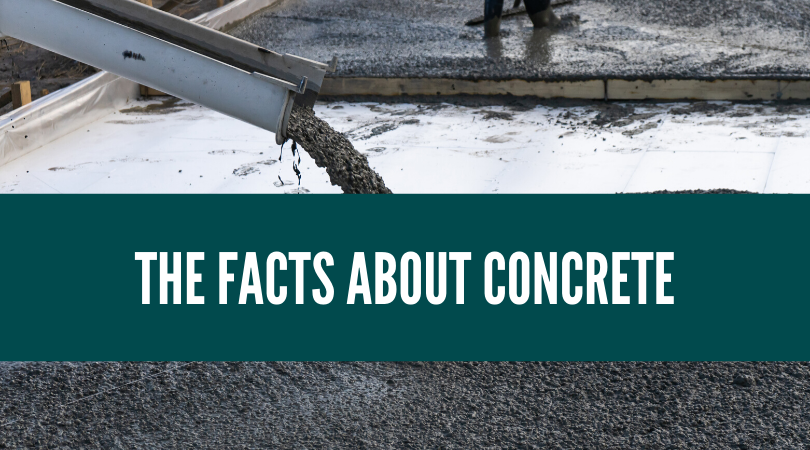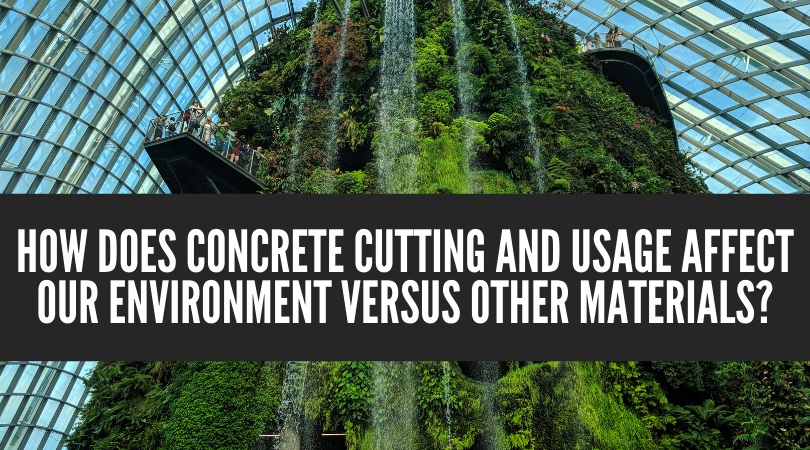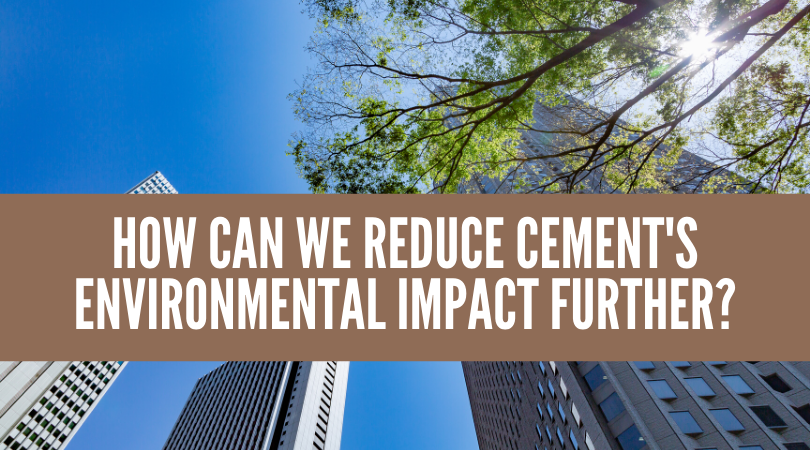It’s the year 2020. There may not be flying cars and automatons roaming our cities. But, the need for a futuristic approach in our environment is dire. Your carbon footprint matters. Not only as a person, but an employee or business owner. It is the only thing that helps to either better or worsen our environment. With this being said, it’s about time that we take a look at our own industries (cement, construction, concrete, etc.). Let’s delve into how they affect the lives of everyone around us and those of us yet to come.
For all of us at Sawcutting Specialties, we take our local environment seriously. We also take the lives of our children and grandchildren very seriously.
That’s why we’ve done the research for our own industry. In order to not only help our team feel at ease, but to help our countless customers as well.
By breaking down the facts about concrete, we can see the truth. By determining how it affects our environment in comparison to other materials, we can feel at ease. And, by determining how we can reduce its impact even further moving forward, we can be informed. We can finally ensure that all of our products aid in a brighter tomorrow. On top of this, we can create projects that we can proudly stand by for decades to come. Having said that, we hope you approve of the hard work that went into this research compilation. Furthermore, we look forward to your thoughts on the subject both under this post and on our social media accounts as well.

The Facts About Concrete
To begin, we must first address some of the main concerns. These are concerns that environmental activists have with the concrete industry as a whole. These concerns stem from the production and materials used. Specifically, those used to make the Portland cement that is utilized in 95% of projects on the market as of now.
According to Building Green, “The Inventory of Carbon and Energy at the University of Bath in the U.K. estimates that it takes 4 million Btu to produce one ton (0.9 metric tons) of portland cement. According to the U.S. Department of Energy, portland cement production accounts for about 0.33% of the annual energy consumed in the U.S, roughly equivalent to the amount of energy in 13 million tons (12 mmt) of coal.”
Considering how much concern goes into coal usage in America and how cement production holds up against this other carbon-emitting giant, it’s no wonder why many eco-friendly companies have criticized the industry and sought cement alternatives.
In conjunction with these statistics, another source, Del Zotto Steel and Concrete states, “If you’ve been contracted to make any kind of building, odds are you’ll be using cement for slabs, walls, tunnels, and more. Cement is made throughout the world by heating limestone and clay to a high temperature in kilns, a process which releases high amounts of carbon dioxide. The fossil fuel generally used to heat these kilns also releases the gas as it burns. But modern society can’t do without cement.”
However, despite these facts, many new studies have revealed that the fear of utilizing cement in projects across the globe may be a bit more premature than we once thought.
In fact, some studies have revealed that concrete not only is recyclable and efficient for building purposes but actually absorbs carbon emissions over its lifetime as well making up for a large portion of the carbon it emits during the production process.
According to Science Magazine, “[a team of Chinese scientists, including physicist Zhu Liu, now at the California Institute of Technology in Pasadena] estimate that between 1930 and 2013, cement has soaked up 4.5 gigatons of carbon or more than 16 gigatons of CO2, 43% of the total carbon emitted when limestone was converted to lime in cement kilns. That’s more than 20% of the carbon soaked up by forests in recent decades, they write.
Given the information above, it’s about time that we now analyze how concrete cutting and usage for projects actually affects our environment in comparison to other building materials below. By doing this, we can finally put to rest these environmental concerns and prove the exponential value in utilizing concrete for construction once and for all.

How Does Concrete Cutting and Usage Affect our Environment Versus Other Materials?
Despite the statistics shown above, it is essential that we keep them in perspective. In the same article by Building Green, the author goes on to state, “As high as these numbers are, it’s important to keep them in perspective. According to the University of Bath, cement has lower embodied energy per pound. Lower than steel, aluminum, fiberglass insulation, and many other building materials. Concrete’s embodied energy is significantly less—about the same as cellulose insulation. However, these “cradle-to-gate” figures are not directly comparable. This is because the materials have different properties and functions. Still, the numbers offer some perspective. Manufacturing Portland cement accounts for approximately 5% of the anthropogenic CO2 emissions worldwide. It also accounts for about 2% of total CO2 emissions in the U.S.”
Furthermore, “a study published by Nature Geoscience suggests that once a structure is completed, the concrete and mortar used may absorb back a significant amount of carbon dioxide from the air, due to a natural chemical reaction with water and oxygen. This even applies to rubble from concrete demolition. The study indicates that perhaps 43 percent of the carbon dioxide a given volume of cement released into the air during manufacture is being soaked up again over time.”
However, this is far from the only way in which concrete positively affects the environment and proves its sustainability over time.
On top of these facts, concrete is also a recyclable material that also proves its worth in many ways. Through its durability, thermal mass, and the availability and abundance of its raw materials. This includes a large proportion of secondary materials.
Because concrete has a high thermal mass level overall, concrete helps to reduce heating and cooling energy usage, as well as the carbon emissions stemming from the AC units, found worldwide. Furthermore, concrete also demonstrates its strength and water tightness in regions such as the Netherlands that rely on concrete to form natural disaster-resistant floating homes.
These homes could very well be the future of areas across the globe plagued by flooding and also provide hydropower solutions that would reduce carbon emissions over time worldwide likewise.
Lastly, according to The Concrete Initiative, “The industry recognizes the impact of its resource extraction activities on the landscape. For example, the cement industry has developed a clear set of principles on quarry rehabilitation under the auspices of the World Business Council for Sustainable Development’s Cement Sustainability Initiative. It has also invested in quarry rehabilitation programs. For example, the Landscape Rehabilitation Plan in the SECIL-Outão Plant (Portugal) integrated a marl and limestone quarry back into the natural landscape, and restored the native vegetation.”
With this being said, not only have recent studies suggested that concrete is recyclable, absorbs carbon emissions, could be a solution for flooding and climate change worldwide, and is highly durable compared to other materials being used in construction today.
In fact, on top of this, the leaders of this industry are also working tirelessly to encourage biodiversity and help counteract the other 57 percent of carbon emissions seen in concrete production overall.
Having said all of this, there are still other issues these leaders are hoping to nullify over time by reducing concrete’s environmental impact even further in the upcoming decade. This is the final topic of discussion we chose to delve into below.

How can we Reduce Cement’s Environmental Impact Further?
Now, we’ve discussed both the positives and negatives of cement production and usage thus far. As such, it’s time that we analyze the ways leaders aim to make concrete even more efficient over time.
For starters, the production process is one of the main concerns that environmental groups and activists have with concrete currently. This is one of the main areas in which these leaders have sought to make improvements in the upcoming years.
Such improvements include the way that the kilns are heated and the materials that concrete is made up of specifically. By affecting these two elements, you can create what is often considered to be ‘green concrete’. Through this, you can ensure that your construction projects are even more cost-effective and environmentally friendly.
To elaborate on these changes, let’s start with substitutions to the materials currently being used in the production process. According to Nearby Engineers, “Green concrete is defined as concrete that uses waste material for at least one of its components, or concrete with a production process that does not cause environmental destruction. Green concrete is very similar to conventional concrete. But, its production requires less energy and causes less harm to the environment.”
Some of the main concrete material alternatives include:
- Recycled concrete
- Fly ash
- Ground Granulated Blast-Furnace Slag (GGBS)
- Silica fume
- Limestone fines
These materials are often used to replace large portions of the portland cement currently being utilized. Most of these materials lead to concrete mixtures that require slightly longer curing processes. However, they also all lead to green concrete likewise.
There is another material alternative currently being workshopped by a company called Solidia. This too may also be an excellent alternative in the future likewise. As stated by Solidia themselves in regards to the mixture, “Wollastonite-derived cement has a lot less calcium than Portland cement. So to replace wollastonite, Solidia could reduce the amount of limestone and increase the amount of clay in the mix it sent to the kiln. With less limestone to convert to lime, the process could use less heat. Cutting out limestone reduced CO2 emissions from both the chemical reaction and from the fossil fuels needed to heat the process…Unlike Portland cement, Solidia’s mixture doesn’t harden simply after adding water; it requires the absorption of climate-killing CO2.
The concrete blocks resulting from the process capture about 240 kg of carbon dioxide for every 1,000 kg of cement used in the mixture. That’s on top of fewer emissions producing during the manufacture of Solidia’s cement. Over its lifecycle—from limestone to cement to concrete—Solidia produces up to 70% fewer emissions, compared to Portland cement. So if 1,000 kg of Portland cement releases 1,000 kg over its lifecycle, then Solidia cement releases only 300 kg.”
So, why are these alternatives already being workshopped and used to replace the current cement mixtures we see today?
Well, the answer is simple; doing so wouldn’t actually affect construction workers or the industry at all.
According to The Conversation, “The BZE report calculates that 50% of the conventional concrete used in construction can be replaced with another kind, called geopolymer concrete. This contains cement made from other products rather than limestone, such as fly ash, slag or clay.”
Imagine if the concrete industry as a whole were to encourage these green mixtures moving forward. Furthermore, imagine if they utilized recycled concrete for the other 50 percent of these projects. That alone could absolutely revolutionize the construction industry. It would also absolutely put to rest the fears associated with concrete construction once and for all.
As for how our diamond saw blades would handle this change, the answer is simply ‘with ease’. Diamond blades make cutting through concrete precise and smooth. Therefore, changing the cement mixture wouldn’t affect these products whatsoever. If anything, we should be promoting wet diamond blade cutting in conjunction with these policies above. Through this, we could actually make even more of an impact on potential air pollution likewise.
In conclusion, it is pretty clear to see. The concrete industry is not as harmful to the environment as it seems.
In fact, concrete and construction industry leaders are hoping to take this one step further. They aim to do this by creating new cement mixtures. These mixtures would promote CO2 absorption and reduce emissions caused by the production process. Through this alone, we hope to create a brighter future and a stronger industry as a whole.
If you would like to know more about our products and how they will absolutely be the most effective blades for this potential concrete mixture transition, don’t hesitate to contact our team today! We are always ready to take on your questions! We look forward to being part of the solution in our industry and in our community as well!
